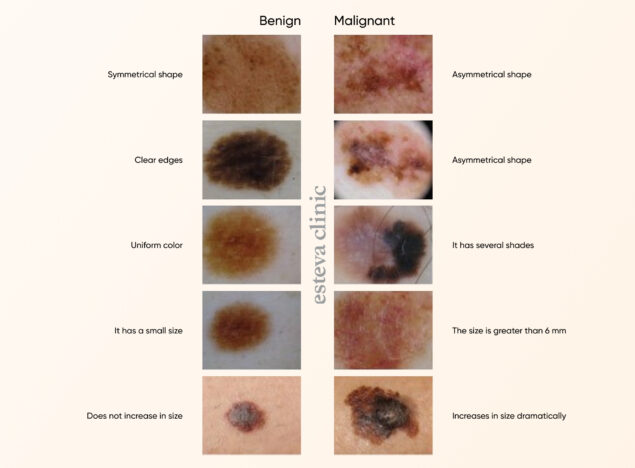How to determine whether a mole is benign or malignant
Often when faced with a neoplasm on the skin, the question arises of how to distinguish a benign mole from a malignant one. Nevi on the body are a common occurrence and in most cases are safe. However, sometimes changes in their color, size, shape or texture can be a signal of dangerous diseases, such as melanoma. Knowing the key signs of malignant skin lesions and seeking medical help in a timely manner can significantly increase the chances of successful treatment.
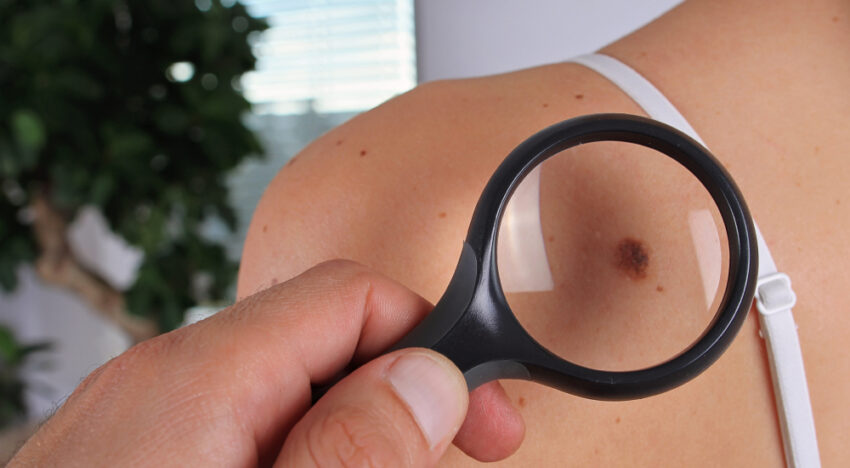
Benign and malignant moles have differences that are important to recognize. In this article, we will tell you in detail how to independently monitor the condition of moles on the body and how often you should visit a dermatologist.
How to distinguish a benign mole from a malignant one
Self-diagnosis of moles on the body is definitely a useful skill, especially for those with fair skin with a large number of nevi. Constantly checking the condition of the skin can help detect a problem at an early stage, which significantly increases the chance of quick and effective treatment.
However, we note that self-diagnosis is not the only tool for monitoring moles. It is important to regularly visit a dermatologist, whose services are provided by various clinics in Ukraine. When choosing a place to make an appointment, look only for a clinic with a good reputation, a license and positive customer reviews. Esteva Clinic is exactly such a clinic – we have been successfully helping our patients to be healthy, beautiful and happy since 2015!
Signs of a malignant mole
Under the influence of various factors, an ordinary harmless mole can turn into a malignant one. Therefore, it is important to know how to distinguish a benign mole from a malignant one and react to the first alarming symptoms in time.
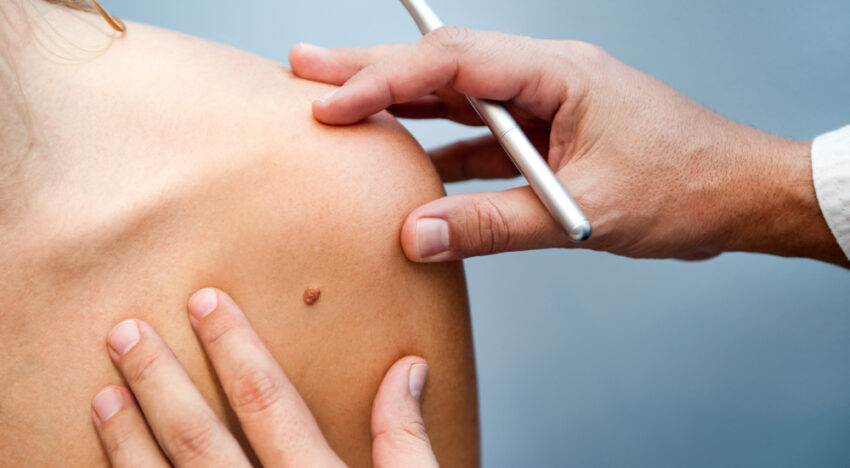
The reasons why benign moles can transform into malignant ones can be different. The main risk factor is exposure to aggressive ultraviolet radiation. Prolonged exposure to the sun without using SPF products or visiting solariums can damage skin cells, causing mutations that lead to the development of melanoma.
Injuries to moles, such as constant friction against clothing, cuts or scratches, can also trigger changes. In addition,hormonal changes (pregnancy, adolescence or menopause) can stimulate active cell growth. Heredity also plays an important role: If close relatives have had cases of melanoma or other types of skin cancer, you should be especially careful to monitor skin lesions.
Signs of a malignant mole may not be noticeable in the early stages, but regular skin examination helps to detect changes in time.Symptoms of changes in nevi that should be alarming:
- the mole is growing rapidly or has changed significantly in size;
- the formation is asymmetrical;
- blurred, jagged or fuzzy contours;
- if different shades appear in the color of the mole (black, brown, red or blue), this is an alarming signal;
- the appearance of peeling, cracks, bleeding or discharge;
- itching, burning, pain, or hardening in the area of the mole.
If you notice any of these symptoms of a malignant mole, it is important to consult a dermatologist as soon as possible.
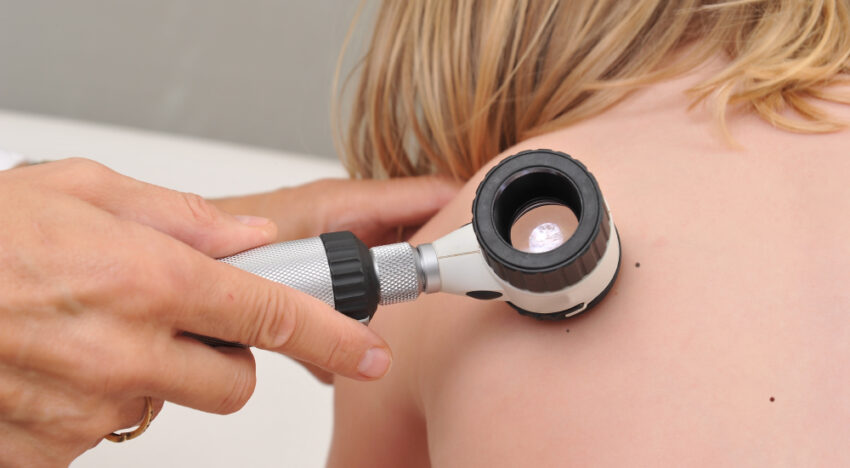
Doctors have also developed a simple and clear way to check the condition of moles at home. This method is called ABCDE and it helps to determine the presence or absence of signs of a malignant mole described above point by point. Explanation of the abbreviation ABCDE:
- Asymmetry – Melanoma is often asymmetrical, which means the shape isn’t uniform. Non-cancerous moles are typically uniform and symmetrical in shape.
- Border – Melanoma often has borders that aren’t well defined or are irregular in shape, whereas non-cancerous moles usually have smooth, well-defined borders.
- Color – Melanoma lesions are often more than one color or shade. Moles that are benign are typically one color.
- Diameter – Melanoma growths are normally larger than 6mm in diameter, which is about the diameter of a standard pencil.
- Evolution – Melanoma will often change characteristics, such as size, shape or color. Unlike most benign moles, melanoma tends to change over time. If you have a mole or skin growth, watch it for signs of changes. If you notice any of the ABCDEs of melanoma, make an appointment right away to be evaluated by a dermatologist.
To better remember the principle of the ABCDE method, we have made a convenient and understandable diagram for you.
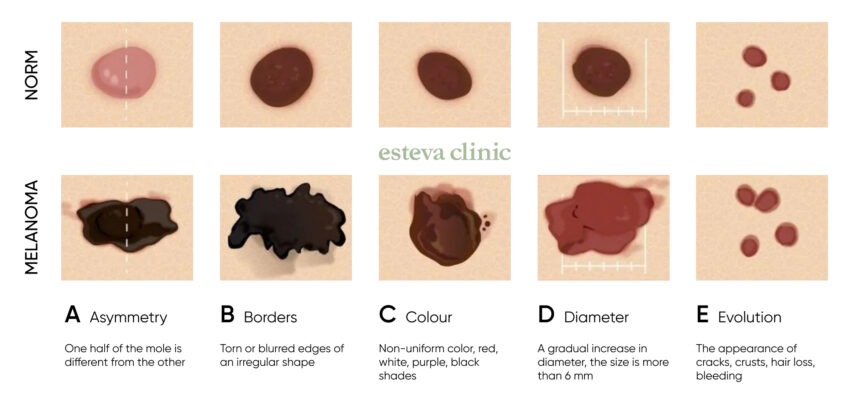
The AKORD method is an excellent tool for regular self-examination, but it is worth understanding that it does not replace professional diagnostics.
If during self-examination you notice changes in a mole or the appearance of a new nevus on the skin that differs from the rest, then you should not ignore the problem. Consult a dermatologist or oncologist who will conduct a professional examination. Dermatoscopy methods are used for accurate diagnostics. If necessary, a biopsy is also performed (examination of a piece of tissue to determine the nature of the formation).
Types of malignant moles
The main and most common types of malignant moles include:
- Melanoma is considered the most dangerous type of malignant skin tumors. It arises from melanocytes, the cells responsible for pigmentation. Melanoma often resembles an asymmetrical mole with jagged edges, uneven color, and a tendency to increase in size. It usually appears on exposed areas of the body that are exposed to ultraviolet light, but can also develop in hidden areas.
- Basal cell carcinoma is a type of skin cancer that forms from the basal cells of the epidermis. Although it rarely spreads throughout the body, the disease can affect surrounding tissue. In the early stages, basal cell carcinoma appears as a small pinkish or flesh-colored nodule that may crust, peel, or bleed.
- Squamous cell carcinoma arises from the cells of the upper layer of the epidermis. It appears as rough, scaly patches, ulcers, or dense formations with jagged edges. Squamous cell carcinoma most often develops in areas of the skin that have been exposed to the sun for a long time.
- Merkel cell carcinoma is a rare but extremely aggressive type of skin cancer. It is most often found in older people. This formation usually looks like a fast-growing, painless tumor of red, bluish or flesh color.
Each of these types of malignant moles requires careful attention and timely diagnosis, as they carry serious health risks.
Benign mole – signs of nevi on the body
Benign moles, or nevi, are common pigmented formations on the skin that are formed from a cluster of melanocytes. They can be of differentsize, shape and color, but have common features that distinguish them from dangerous changes. As we have already described in the previous section, a benign mole can be distinguished from a malignant one using the ABCDE method. Signs of a benign mole include a symmetrical shape, smooth and clear edges, uniform coloring and a stable size that does not change over time. These moles do not cause discomfort such as itching or pain, and are not prone to bleeding.
It is important to remember that benign moles rarely become a cause for concern if their condition remains unchanged. However, even seemingly harmless nevi on the body require regular monitoring, especially if they are located in areas exposed to friction or sun exposure.
Benign and malignant moles – photos
The photos below will help you understand how exactly benign and malignant moles differ visually.
How often should you check your mole
Regularly checking moles is an important part of skin disease prevention. Estewa specialists have already covered this topic in detail in the article “The danger of moles: when to see a dermatologist”. Below we will repeat the main points that everyone should know.
A malignant mole often develops gradually and timely detection of changes helps prevent serious consequences. How often you need to check your moles depends on the condition of your skin, the number of nevi, and a number of other factors.
It is recommended to perform a self-examination of the skin at least once a month. Use the ABCDE scheme that we described above for this. This will help you notice alarming changes that may indicate a problem with skin lesions. If you see asymmetry, blurred edges, uneven color, or rapid growth of a mole, it may be a malignant mole – signs of such changes require immediate medical attention. This is especially important if there is a suspicion of melanoma (for example, such a disease has already been diagnosed in one of your blood relatives). It is worth remembering that the so-called “benign melanoma” is a misconception, since any melanoma is a dangerous type of skin cancer.
It is recommended to undergo a professional examination by a dermatologist at least once a year. The doctor will be able to determine the condition of your nevi and identify types of malignant moles at an early stage. If you have additional risk factors, you may need to see your doctor more often.
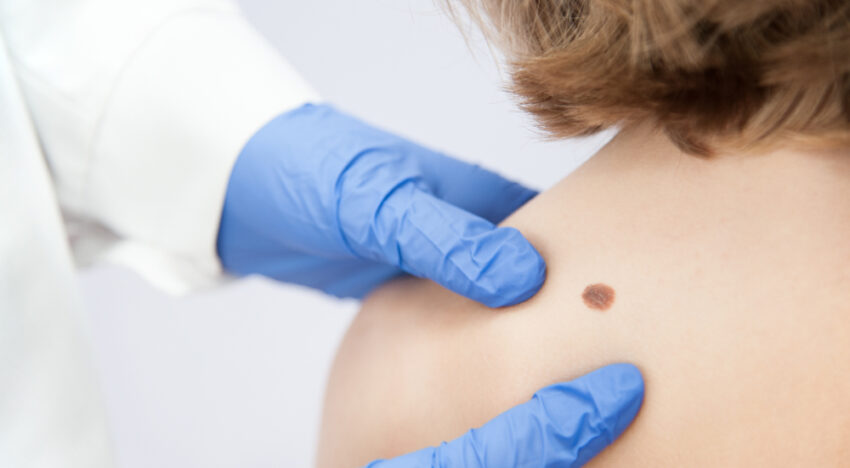
More frequent check-ups are required if you have the following features:
- fair skin that burns easily in the sun;
- a large number of moles all over the body (more than 50) or the presence of large nevi;
- family history of skin cancer, especially melanoma;
- frequent and prolonged exposure of exposed areas of skin to sunlight;
- moles are subject to constant mechanical trauma (for example, clothing);
- significantly weakened immunity due to cancer treatment or other serious illnesses.
Remember that regularly monitoring the condition of the skin is important for everyone, but people at risk need to be especially careful. If you notice any changes, consult a doctor immediately. Regular check-ups at home and in the dermatologist’s office are the key to healthy skin and the prevention of serious illnesses.
During the examination, the doctor will conduct a thorough dermatoscopy and decide whether additional studies are needed. About that, is histology/dermatoscopy necessary before removing moles we have already described in detail earlier.
Checking a mole at the Esteva Clinic
The Esteva Clinic, a clinic of aesthetic medicine and dermatology, has been operating since 2015. Our clients trust us with their health and highly appreciate the quality of the services we provide. This is evidenced by the clinic’s high rating on Google reviews – 4.8 stars out of 5 based on more than 140 reviews.
For our aesthetic medicine and dermatology clinic, the safety, health and comfort of patients are always an absolute priority. We are convinced that only with complete trust and compliance with high standards can we achieve the best results, so each procedure in our clinic is carried out in compliance with strict safety protocols.
Esteva Clinic has a license to practice medicine. Our reputation and commitment to excellence are demonstrated not only by satisfied customer reviews, but also by numerous awards – Choice of Country 2022 and TOP 20 Ukrainian Business Awards 2023.
You can find out how Esteva Clinic specialists work on removing skin lesions in a short video.
Cost of checking and removing moles in Kyiv
Many clinics in Kyiv perform mole removal. Esteva Clinic can offer you not only professional removal of neoplasms using the most modern equipment, but also pleasant prices for procedures.
You can find out the current prices and current promotions for mole removal in the Esteva Clinic below.
Видалення родимок та невусів
| Назва процедури | Ціна, грн |
|---|---|
| Консультація дерматолога обов’язкова | 790 |
| Контроль після видалення з 30 по 45 день | Безкоштовно |
| Родимки, травмовані новоутворення, невус, поліпи - видалення з гістологією новоутворення до 1 см | 2300 |
| Родимки, травмовані новоутворення, невус, поліпи - видалення з гістологією новоутворення до 2 см або на повіці | 3300 |
| Родимки, травмовані новоутворення, невус, поліпи - видалення з гістологією новоутворень до 1 см до 3 шт | 5900 |








